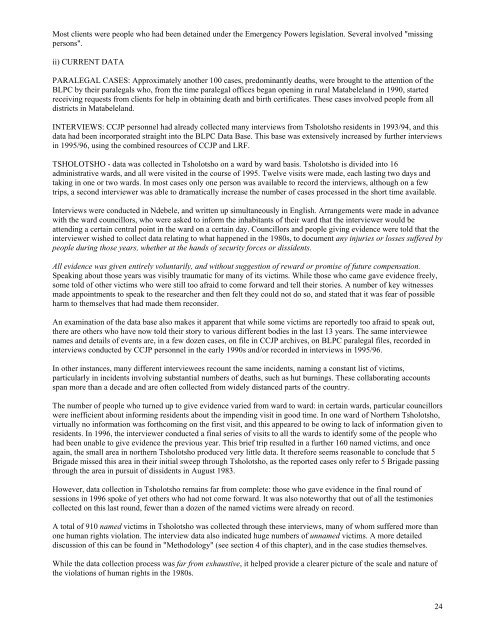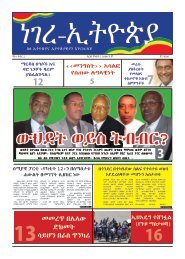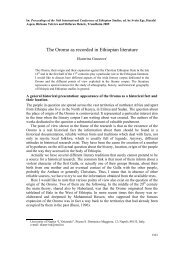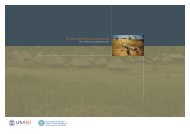MatabelelandReport
MatabelelandReport
MatabelelandReport
You also want an ePaper? Increase the reach of your titles
YUMPU automatically turns print PDFs into web optimized ePapers that Google loves.
Most clients were people who had been detained under the Emergency Powers legislation. Several involved "missing<br />
persons".<br />
ii) CURRENT DATA<br />
PARALEGAL CASES: Approximately another 100 cases, predominantly deaths, were brought to the attention of the<br />
BLPC by their paralegals who, from the time paralegal offices began opening in rural Matabeleland in 1990, started<br />
receiving requests from clients for help in obtaining death and birth certificates. These cases involved people from all<br />
districts in Matabeleland.<br />
INTERVIEWS: CCJP personnel had already collected many interviews from Tsholotsho residents in 1993/94, and this<br />
data had been incorporated straight into the BLPC Data Base. This base was extensively increased by further interviews<br />
in 1995/96, using the combined resources of CCJP and LRF.<br />
TSHOLOTSHO - data was collected in Tsholotsho on a ward by ward basis. Tsholotsho is divided into 16<br />
administrative wards, and all were visited in the course of 1995. Twelve visits were made, each lasting two days and<br />
taking in one or two wards. In most cases only one person was available to record the interviews, although on a few<br />
trips, a second interviewer was able to dramatically increase the number of cases processed in the short time available.<br />
Interviews were conducted in Ndebele, and written up simultaneously in English. Arrangements were made in advance<br />
with the ward councillors, who were asked to inform the inhabitants of their ward that the interviewer would be<br />
attending a certain central point in the ward on a certain day. Councillors and people giving evidence were told that the<br />
interviewer wished to collect data relating to what happened in the 1980s, to document any injuries or losses suffered by<br />
people during those years, whether at the hands of security forces or dissidents.<br />
All evidence was given entirely voluntarily, and without suggestion of reward or promise of future compensation.<br />
Speaking about those years was visibly traumatic for many of its victims. While those who came gave evidence freely,<br />
some told of other victims who were still too afraid to come forward and tell their stories. A number of key witnesses<br />
made appointments to speak to the researcher and then felt they could not do so, and stated that it was fear of possible<br />
harm to themselves that had made them reconsider.<br />
An examination of the data base also makes it apparent that while some victims are reportedly too afraid to speak out,<br />
there are others who have now told their story to various different bodies in the last 13 years. The same interviewee<br />
names and details of events are, in a few dozen cases, on file in CCJP archives, on BLPC paralegal files, recorded in<br />
interviews conducted by CCJP personnel in the early 1990s and/or recorded in interviews in 1995/96.<br />
In other instances, many different interviewees recount the same incidents, naming a constant list of victims,<br />
particularly in incidents involving substantial numbers of deaths, such as hut burnings. These collaborating accounts<br />
span more than a decade and are often collected from widely distanced parts of the country.<br />
The number of people who turned up to give evidence varied from ward to ward: in certain wards, particular councillors<br />
were inefficient about informing residents about the impending visit in good time. In one ward of Northern Tsholotsho,<br />
virtually no information was forthcoming on the first visit, and this appeared to be owing to lack of information given to<br />
residents. In 1996, the interviewer conducted a final series of visits to all the wards to identify some of the people who<br />
had been unable to give evidence the previous year. This brief trip resulted in a further 160 named victims, and once<br />
again, the small area in northern Tsholotsho produced very little data. It therefore seems reasonable to conclude that 5<br />
Brigade missed this area in their initial sweep through Tsholotsho, as the reported cases only refer to 5 Brigade passing<br />
through the area in pursuit of dissidents in August 1983.<br />
However, data collection in Tsholotsho remains far from complete: those who gave evidence in the final round of<br />
sessions in 1996 spoke of yet others who had not come forward. It was also noteworthy that out of all the testimonies<br />
collected on this last round, fewer than a dozen of the named victims were already on record.<br />
A total of 910 named victims in Tsholotsho was collected through these interviews, many of whom suffered more than<br />
one human rights violation. The interview data also indicated huge numbers of unnamed victims. A more detailed<br />
discussion of this can be found in "Methodology" (see section 4 of this chapter), and in the case studies themselves.<br />
While the data collection process was far from exhaustive, it helped provide a clearer picture of the scale and nature of<br />
the violations of human rights in the 1980s.<br />
24







